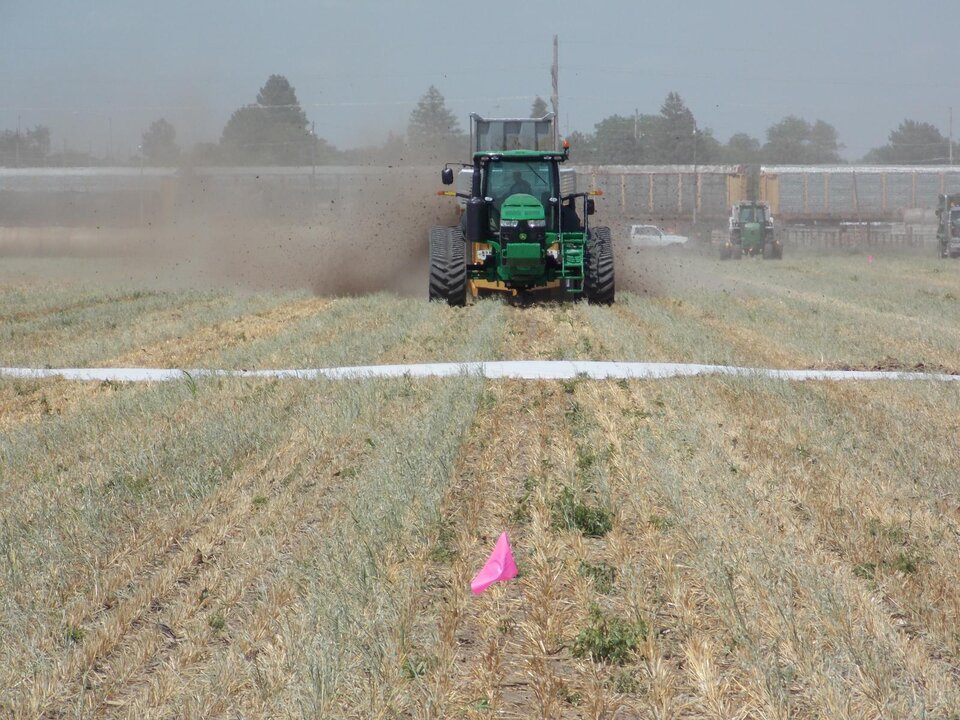Manure Spreader Calibration

As crops come out of the field, manure application equipment typically begins going in. While knowing the nutrient concentrations in your manure, the nutrient levels in the soil, and the nutrient needs of future crop needs are important, another critical component of the manure application process is using the right manure spreader setting, speed, and lane spacing during application. Combining all of these factors to optimize application efficiency is called calibrating the manure spreader.
Calibration Methods
A couple of different methods exist for determining the application rate of a manure spreader. You can determine average application rate by applying a known volume or weight of manure over a known area of ground and then simply dividing the volume or weight of manure applied by the area covered to reveal the application rate in gallons per acre, tons per acre, etc. With today’s GPS-enabled cell phones and similar devices, the distance traveled while spreading a load of manure is easily determined. Without such a device, measuring distance traveled and width of the application pattern by using a measuring wheel or tape, enables you to calculate area covered as Length of Area (ft) x Width of Area (ft). Divide this area by 43,560 to convert the area from square feet to acres. Determining application rate is then accomplished by dividing the volume or weight of manure applied by the area covered.
Example
If a solid manure spreader with a capacity of 6 tons travels 2,000 feet and applies manure over a 30’ wide path, the area covered is (2,000 ft x 30 ft)÷43,560 ft2/ac = 1.4 acres. If all of the manure is emptied from the spreader over this travel path, the application rate is 6 tons÷1.4 acres = 4.3 tons per acre.
The second method for calibrating a spreader involves laying out plastic sheets (for solid manure) or rain gauges/cups (for liquid manure) to catch manure as the spreader or center pivot moves across a field. This is a particularly useful method if the capacity of the manure spreader is unknown or if a center pivot system is being calibrated. For center pivot, place four to six rain gauges, buckets, or other straight-sided containers in line from the pivot center point out to the end of the pivot span at roughly even intervals. Run the pivot so that application begins before it reaches the rain gauges, and continues until the pivot is completely past the gauges. Measure the depth of liquid captured in each gauge or bucket, add the values together, and divide by the total number of gauges used to determine the average application rate across the entire span of the pivot. A similar method can be used with a traveling gun applicator by placing buckets in a line perpendicular to the pull lane of the gun and measuring the depth of liquid in each container once the gun has passed by.
For solid manure applicator calibration, you will need a five-gallon bucket, three to four sheets of plastic or tarp, and a scale capable of measuring the weight of the bucket and its contents. The plastic sheets or tarps should measure a 6.5 ft x 8 ft. 10.25, providing a total collection area of 66 square feet. Begin by weighing the five-gallon bucket with one tarp or plastic sheet inside of it. Lay the plastic sheets or tarps on the ground in a line in the direction that you will travel with the spreader, leaving a few feet of space between each sheet. Drive over the sheets while spreading manure at your normal operating speed. Pick up each sheet being careful not to let any of the manure fall off. Place the sheet and manure inside the plastic bucket and weigh the bucket again. Repeat this for each sheet. For each weight, subtract the weight of the bucket and sheet that you determined in the first step and record these values. Finally, divide the weight of manure collected on each tarp by 3. The result of this calculation will be the manure application rate in tons per acre. An average application rate can be determined by adding the rates you calculated for each sheet and dividing by the number of sheets used. By repeating this with three or more plastic sheets or tarps, a more accurate application rate can be determined than would be possible with just a single sheet being used.
Additional Information
- Manure Calibration Kits are available at a number of UNL Extension offices across the state. Find a kit near you.
- Manure Applicator Calibration Guide